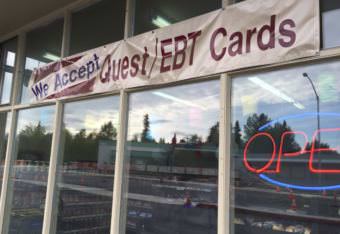
Mary Wood has been waiting for food stamps since she filed a renewal application in August. She takes care of three of her grandsons intermittently, and qualified for more than $800 a month in benefits.
“Around Christmas it was really hell,” she said. “I told my landlord, ‘I don’t have any money to give you. I can’t even buy the kids presents.”
Now she says her refrigerator and freezer are all but empty — she and her grandsons eat things like oatmeal, peanut butter and jelly sandwiches, and dehydrated emergency food rations that she’d purchased in case of a natural disaster. “It’s survival food,” she said, and added that she usually adds meat or vegetables to it when she can.
Wood borrowed money from her daughter to keep up with bills for a few months. She said she is now behind on rent again after she spent her income on food, but feels lucky because her landlord hasn’t kicked her out — instead he shares moose meat with her and gives her quarters for the laundry machine.
She said she’s visited and called the Division of Public Assistance multiple times, and they tell her the application is in the system so she just has to wait. She said the situation makes her feel worthless. “It’s really hard,” she said.
She’s one of thousands of Alaskans who waited for months for food stamps, due to extreme delays in the Division of Public Assistance. The state says it has worked through thousands of backlogged applications, but thousands more Alaskans are still without food benefits.
Chipping away at an 18,000 person backlog
The state’s own reporting says that so far in 2023, the Division of Public Assistance has processed fewer than a third of its food stamp renewals on time this fiscal year. But division Director Deb Etheridge said that’s been turning around in recent months.
“I’m feeling really positive,” she said. “We’ve implemented some pretty significant changes in our staffing pattern, in order for us to not only take care of the backlog, but also assure that it doesn’t grow.”
The state pledged to cut its 10,000 person wait list for new food stamp benefit applications in half by the end of October as a result of a class-action lawsuit filed in May. Etheridge said that the backlog is down to 8,794 people as of last week. If the state fails to meet the deadline the lawsuit will continue, but Etheridge said they are on track. Staff is divided into teams: Some work on the backlog while others tackle incoming applications for food stamps. A third team works on Medicaid renewals.
And Etheridge is celebrating a partial victory: The division cleared all the recertification applications in its backlog. There were more than 8,000 of those earlier this year, she said.
The state has put millions of dollars towards solving the problem since this spring, including $6.8 million of state and federal funds toward staff for the Division of Public Assistance. Etheridge said she’s hired 46 new eligibility workers and has 19 positions posted. Twenty more hires are pending.
“We are really aggressively recruiting to hire,” she said. “We are not adequately staffed up yet for keeping current.”
As of this month, the average decision time for SNAP benefits this fiscal year was nearly 60 days — double the federal limit.
“It’s getting better. It’s getting hopeful.”
An eligibility worker that spoke out about understaffing and systemic issues in the Division of Public Assistance in the early days of the backlog said that things have turned around since this April. Eligibility workers process paperwork for state benefits. The Beacon is not using their name because they fear they could lose their job for speaking out.
“It’s getting better, it’s getting hopeful,” they said.
The eligibility worker said they and their colleagues are back to processing cases and getting people food stamp benefits again, rather than being tied up on the phone with distraught families. That’s thanks in part to the state hiring contract workers to handle its phone system.
But the eligibility worker said another stress point is gone, too. From October of last year until this April, eligibility workers weren’t allowed to process cases on the phone. They said new management changed that.
“This director and commissioner have been really working on getting it done, on getting us actually working cases,” they said. “We’re able to help people like we haven’t been able to before.”
The eligibility worker said Mary Woods’ nine-month wait is pretty normal—it’s what happens when an application is submitted into the system, but not entered into the database. The worker said they saw a few other cases from August in the last couple of weeks, and it’s likely other eligibility technicians do, too.
They say they’re also excited about policy changes in the division that should reduce the paperwork burden on families and staff. Alaskans used to have to renew their food stamps applications every six months, but that will be increased to a year. And starting in December, there will be an online application for food stamps like in the rest of the country.
“I’m proud of our union, administration and workers for doing this work,” they said. “It’s about time.”
This story originally appeared in the Alaska Beacon and is republished here with permission.



